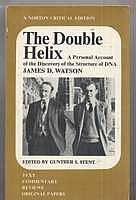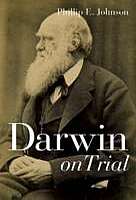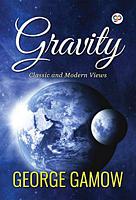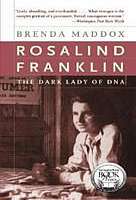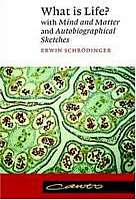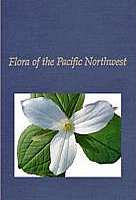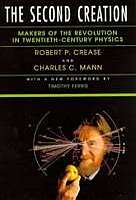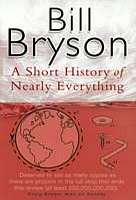 Science
Science
Honest Jim
Watson's superb account of his and Crick's discovery of the structure of DNA. It is the rarest of books: a scientific page-turner, with suspense, strong personalities and a child-like narrator.
Wide of the Mark
Johnson's book provides a perspective on creationist thinking and argumentation. It demonstrates that attorneys are trained to advocate, to argue, not to look hard for the best understanding.
Gamow on Gravity
Those genuinely curious about the intellectual story of gravity will find Gamow a superb teacher, one adept at explaining physics to the uninitiated,and to the newly initiated, high school and college students, most effectively to an audience comfortable with algebra and geometry.
The Dark Lady of DNA
Rosalind Franklin made critical contributions to the discovery of DNA's structure, yet was not awarded the Nobel. Why not? Rank villainy? Maddox's masterful recounting lays out the complex tale.
Short and sweet
A Brief History of Time is the single best popularized science book I have read to date on the subject of modern physics. It has been held that kind of regard since it has been published in 1988, but I resisted reading it, because I had formed the opinion that modern physics, buried so deeply in mathematical models divorced from everyday experience, was simply too difficult to convey to the non-practitioner, that vast group including myself.
The moons of Jupiter
The fascination of astronomy for me, beyond the beauty of the night sky, beyond the immense imponderables of a vast and ancient universe, is that our understanding of the universe has been gleaned by observing a few points of light in the sky. One illustration of this can be found in the history of our knowledge of the moons of Jupiter.Entropy is so simple
Peter Atkins, a bona fide chemistry professor, takes a shot at summarizing the Laws of Thermodynamics, particularly the 2nd Law, for the million. He claims that when he is done explaining, you will understand how all change of any kind occurs, why death itself must come, even how the unfolding of the very thoughts you are employing to read his book is a consequence of the 2nd Law. Alas his explanations fall short of such a lofty goal.
Pandora has many boxes
 The ability to directly and much more easily modify the genome of any living organism, via somatic or germline modification, has become a reality via CRISPR-Cas9 techniques. Chinese scientist He Jiankui recently claimed to have opened yet another of Pandora's seemingly endless set of boxes: Germline gene editing. Jennifer Doudna's recent book A Crack in Creation, a must-read, warns about premature application of CRISPR-Cas9.
The ability to directly and much more easily modify the genome of any living organism, via somatic or germline modification, has become a reality via CRISPR-Cas9 techniques. Chinese scientist He Jiankui recently claimed to have opened yet another of Pandora's seemingly endless set of boxes: Germline gene editing. Jennifer Doudna's recent book A Crack in Creation, a must-read, warns about premature application of CRISPR-Cas9.A Finch in Time
The Beak of the Finch follows a husband and wife scientific team, Peter and Rosemary Grant, in their studies of Darwin's finches on Daphne Major island in the Galapagos archipelago, looking for evidence of natural selection. They have spent twenty years observing the finch population for direct evidence of natural selection. They concluded from these observations that natural selection is occurring daily.
Too simply pure
The Poincaré conjecture, one of the great unsolved topological problems, was finally proven at the end of the 20th century by Grigoriy Perelman, a Russian mathematician of genius. Topology might be described as distilled geometry. The historian Masha Gessen, who grew up herself in the Russian mathematical culture, invites us into the Aspergian milieu of world-class geometers to tease out the tale.
Are there Laws of Medicine?
Modern medicine began embracing scientific methods during the last couple of centuries, and in the past one hundred years this has produced an explosion of medical technologies that have aided physicians in significantly controlling some diseases and in particular, extending lives. Today in developed countries, many tests are available for diagnosis and many drugs are available for possible treatment. So why can't physicians today just run a comprehensive battery of tests for every sick patient and spit out a clear diagnosis, and with that, a clear prognosis and plan for a cure? Siddhartha Mukherjee proffers an answer via his Laws of Medicine.

Galaxy NGC 1300. Attrib: NASA, modified, PD-USGOV.
Evolution + Intelligent Design = 42
Are evolutionary biology, intelligent design and the existence of God compatible? A reasonable case can be made for it, particularly if one relaxes their culture warrior muscles for a moment, and considers the argument that: science offers little tangible evidence of abiogenesis, the spontaneous creation of life from inanimate material, leaving room for God as the creator of the initial life forms; that God could just as well have created the remainder of life via the slow mechanism of biological evolution. This is not a new argument, and finds a much larger audience than the shouters like to acknowledge.
Has Lamarckism been revived?
Epigenetic studies are burgeoning; these genetic mechanisms that are external to direct DNA/RNA encoding and expression are being intensively studied, particularly how environmental factors can stimulate methylation and acetylation of bases of DNA or histone proteins, which then affects the expression of specific gene activity. Is epigenetic modification heritable, and if so, does this represent a revival of Lamarckism?
Large Scale Genomics in Beijing
Beijing Genomics Institute, BGI, situated in Shenzhen, on the border between Guangdong and Hong Kong, claims the title of the world's biggest Genomics institute. Their president Jian Wang said, 'For the last 500 years, you (the West) have been leading the way with innovation. We are no longer interested in following.' The scale of their sequencing capability is large, as are their goals: to crack hunger, illness, evolution - and the genetics of human intelligence.Evolutionary zinger: Bats, moths and mites
When Fred Rickson taught his section of General Biology at Oregon State, I made sure to attend all of his lectures, as he opened them with his evolutionary zingers, hoping that his students would would be enticed to be more prompt than usual. My favorite was his zinger about the three-way symbiotic relationship between a bat, a moth, and a mite.Evolutionary zinger: Ants and acacia trees
I treasure the science education I obtained at Oregon State University. One standout class was General Biology, a portion of which was taught by professor Fred Rickson. He did not like people slipping in late, so he gave short teasers promptly at the start of the hour, which he entitled evolutionary zingers, hoping that his students would enjoy the stories sufficiently to show up on time. It definitely worked for me. I was not in the habit of attending a lot of lectures, but the intricate stories of complex life told by professor Rickson were as attractive to me as nectar "fountains" are to acacia ants, the subject of one of his zingers.The physical sublety of life
I recently re-read portions Erwin Schroedinger's amazing little book What is Life?, which was a post-war stimulus for a number of physicists to switch from physics to biology and look hard for a physical understanding of living organisms.
Of ovules and ovaries
Flora of the Pacific Northwest is an excellent dichotomous key of indigenous regional flora. It served as one of my texts for a college class in Systematic Botany, which I feared would be deathly dull, and so proved the lectures, but the laboratory unexpectedly turned out to be a rewarding journey exploring the world without and the world within.
The Origins of Modern Science
Herbert Butterfield, in his book The Origins of Modern Science, tells the story of the development of modern science by focusing on the ideational changes in what is now referred to as science from the late Middle Ages until the advent of the French Revolution, with primary emphasis on the development of the modern understanding of motion. This is a brilliant choice, as it was the development of a robust physical and mathematical model of motion that allowed Newton to unite terrestrial and astronomical physics into a universal set of physical laws describing mechanics.
The many ways of misusing quantum physics
Doctor Moriarty, that is physicist Phil Moriarty, holds forth on the various ways of misapplying quantum mechanics, to philosophy, religion, and just about anything but the world of the atom for which it was constructed. He is charmingly cranky about such "Woo".
Is the selfish gene dead?
David Dobbs recently suggested that the 'selfish gene is one of the most successful science metaphors ever invented; unfortunately, it’s wrong.' He purports to uncover a scientific trend in genetics that trumps the understanding of the central role the gene plays in biological evolution. To parrot the author, unfortunately, he’s wrong.Darwin’s endless forms most beautiful
The final paragraph of Charles Darwin's epic Origin of Species is still a viable and beautiful summary of biological evolution. The last phrase reveals both the scientist and the poet:. . . from so simple a beginning endless forms most beautiful and most wonderful have been, and are being, evolved.
In celebration of curiosity
I was asked once by someone close to me why I read the kinds of things I read, or why I would read some things more than once, when much of it didn't seem immediately useful. Upon some thought, I replied that I was simply curious, and that not everything of interest is necessarily or immediately of practical value.
Fuzziness is all
Alongside Newton's powerful physical model of the universe came a growing belief that the universe in principle was deterministic, that the rules by which the universe behaved could be discovered and modeled, were repeatable, and could be in principle exactly or absolutely determined. Absolute determinism came under serious question with the advent of subatomic physics at the start of the 20th century, more or less collapsing in the face of problems insoluble with the physics of Newton and Maxwell, and only explicable by using the new quantum mechanics, which posits that natural phenomena could be modeled at the highest attainable precision only by using explicitly probabilistic models, that is, by building into the models a modicum of fuzziness.Can religion and science be reconciled?
"Adherents of religion and science too often want to own the unknown"
Victor Stenger, a physicist who has written extensively about religion and science, asserts emphatically that science and religion cannot be reconciled, and at best merely coexist in parallel thought universes. His primary argument is that faith requires no evidence and science does. Alfred North Whitehead, in his essay Religion and Science, emphasizes the commonality of change in both science and religion, and that both are more plastic than the controversialists from either camp would acknowledge. Is Stenger one of those controversialists? Can religion and science be reconciled?
Humbled again by particle physics
This is a history of the development of the Standard Model of particle physics, circa 1986. It is well regarded by physicists for its sociological treatment, as well as its attempt to record the false starts and uncertainty that accompany leading edge science; certainly the personalities and their various collaborations and squabbles are vividly rendered. As to the science, it is particularly good in providing a pithy description of how a unified theory of electromagnetic, strong and weak forces gives rise to our description of the early events of the Big Bang theory.
What to believe?
Confusion is the only rational outcome of the questions raised by religion. How can one be certain that God exists or certain that God does not exist, or if God exists, what form God takes? To insist that any religion has the unequivocal answers to these questions is to be blinded by the fear of uncertainty and the fear of death. That is not to say that the religious impulse is a false one. What is the purpose of life? How do we live a good life, a meaningful life, a fulfilled life?Zeno’s Paradox? Not so much
Family.
The first time I heard the tale of Zeno's paradox was in childhood, one night after dinner, with the family still around the table. My father grabbed a random section of the day's newspaper, called for a pencil, and with occasional cramped diagrams in the margins of the newspaper, intense and intent, showed us something that fascinated. Such moments with my father, which were relatively rare, I still treasure. His telling of Zeno's paradox inspired me these years later to attack the subject more vigorously.
Sleepwalking amid new ideas
Arthur Koestler's book Sleepwalkers: A History of Man's Changing Vision of the Universe is an ambitious attempt to describe the development of Western cosmology and astronomy from the Greeks to Newton, with particular focus on Copernicus, Brahe, Kepler, and Galileo. Koestler did not see science as a linear and unbroken line of rational progression; instead he viewed the course of the history of ideas as somnambulant: Many ideas were stumbled upon by men with goals and mindsets alien to the very ideas they uncovered.
Absolute truth is a tough nut
Paul Abramson, an old friend, wrote a Defense of Creationism, or more specifically, a defense of Young Creationism, which posits that the universe was created around 6,000 years ago, based on a literal interpretation of the book of Genesis in the Old Testament. I read this article out of curiosity for Paul's take on it; Paul is the editor of a website dedicated to Young Creationism. In the endless churn over biological evolution, religious opponents often emphasize blind faith in an absolute view, while scientific advocates emphasize the skeptical application of the scientific method to mold necessarily incomplete theories. The Defense of Creationism is a good example of the former.What is science? Maybe not what you think it is . . .
"[Science is] an effective, rational instrument for discerning (tentatively, partially, but always more accurately) the facts of the world."
- Chet Raymo, Skeptics and True Believers, p. 166Taking fundamental science personally
Bryson has produced a brilliant exposition on fundamental science that is highly accessible and engrossing for any good reader. The author covers many topics of physics and astrophysics, including the origins of the universe, nuclear physics, and the origins and geological development of the earth.
Plants talk, too!
As bacteria have been found to be chattering away with each other, it probably doesn't come as a surprise that plants talk, too. Stefano Mancuso, the founder of plant neurobiology (really!), studies plant signaling and communications.
It turns out that plants signal each other in several ways which help them to find nutrients, procreate and defend against predators. Ain't biology wondererful?
Once again, thank you, TED.
Parascience: Fair – or not
In the very first sentence (above) of this collection of essays, who's full title is Absence of Mind: The Dispelling of Inwardness from the Modern Myth of Self, Marilynne Robinson fires an immediate broadside as she sails the still uncharted territory of consciousness, or perhaps, the territory of charting consciousness. The title 'Absence of mind' appears at least a double entendre: The removal of the mystery of the mind by sloppy, imprecise parascience (a word Robinson uses more in the sense of scientism) and a poke at those who would arrogantly misuse the authority of science as being absent of mind.
Evo devo: where a little means a lot
Sean Carroll's overview of the new science of evolutionary developmental biology, or 'Evo Devo.', Endless Forms Most Beautiful, demonstrates new ways of testing Haeckel's old and discarded idea that 'ontogony begets phylogeny'. Evo Devo is bearing serious fruit; it would appear that a small number of genetic changes can produce very large, and species specific, changes, particularly those mutations occurring during an organism’s development or to the gene regulatory mechanisms of that organism; this is strong new support for the theory of evolution.


 Snap out of it!
Snap out of it! READING
READING ARCHIVES
ARCHIVES CATEGORIES
CATEGORIES QUOTES
QUOTES